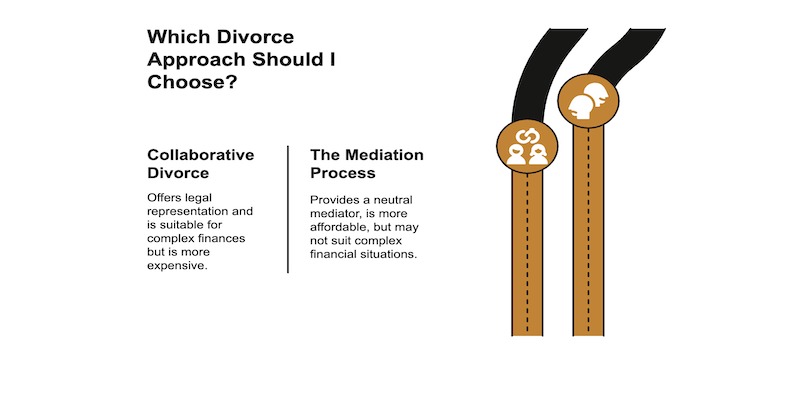One of the most stressful aspects of traditional separations is the looming spectre of having to go to court. The end of a relationship is already a difficult time — but these feelings can be magnified significantly when crucial decisions about the likes of child arrangements and finances are taken out of your hands.
What if there was a way to avoid expensive legal battles, reduce stress, and keep control of your future? Collaborative divorce is an increasingly popular alternative that helps couples reach agreements without stepping into a courtroom. It can help you to resolve complex issues within a more flexible and constructive framework, while also reducing both costs and recriminations. However, as with other forms of Alternative Dispute Resolution (ADR), there are always potential pitfalls that should be taken into account.
Our twelve pros and cons of the collaborative divorce process offer valuable insights into how a reputed 90% of collaborating spouses who used this approach reached successful outcomes.
What is the Collaborative Divorce Process?
During a collaborative divorce, both spouses appoint solicitors who are specifically-trained to offer support and legal guidance throughout the process. If required, additional specialists and consultants can also be employed to advise on childcare, parenting, and finances. To ensure that everyone is committed to a resolution, both parties will need to sign an agreement at the beginning of the process.
The Collaborative Divorce Process Explained
The collaborative divorce process is essentially a series of meetings designed to find lasting solutions to separating couples’ objectives. Once you both understand what’s involved, you’ll work with your respective legal teams and recommended experts to set agendas and constructively tackle difficulties. Before the process formally begins, you and your partner will sign an agreement, as to how the process will unfold.
However, be aware that, as part of this agreement, you will consent with your partner that, if the process breaks down, you will have to start again with new representation.
Step-by-Step Collaborative Divorce Process
- Initial Meeting: Your solicitor explains the collaborative process so you know what to expect.
- First Four-Way Meeting: Both spouses, alongside their solicitors, sign a formal Participation Agreement that outlines a commitment to working towards resolution.
- Subsequent Sessions: These meetings focus on key issues (child arrangements, division of assets, etc.), with flexibility to bring in financial experts or mediators as needed.
- Final Agreement: Once decisions are made, they are formalised in a Consent Order, which a court will approve to make legally binding.
It’s vital to note that, if the process fails, both parties must start again with new solicitors, which can be costly and time-consuming.
12 Pros and Cons of the Collaborative Divorce Process
There are a number of pros and cons of collaborative divorce. The process can help spouses to find lasting solutions to separation that avert the costs and anxiety of protracted litigation. However, it can be more expensive than family mediation and, if the process fails, some people might find starting all over again with new representation frustrating.
If you are considering collaborative divorce vs traditional divorce, here are the main advantages and disadvantages for you to consider.
Pros of Collaborative Divorce
The main advantages of this form of ADR include:
- Less Costly Than Litigation: Avoids expensive court fees and lengthy proceedings.
- Less Stress & Conflict: Encourages constructive discussions, reducing emotional strain.
- More Control Over Outcomes: Unlike a judge-imposed ruling, both spouses shape the final agreement.
- Better for Business Owners: If you own a company, collaboration ensures business continuity while financial settlements are discussed.
- Flexibility in Process & Timeline: Meetings are scheduled based on availability rather than dictated by a court timetable.
- Support from a Multi-Disciplinary Team: Access to financial planners, family consultants, and mental health professionals ensures well-rounded advice.
- More Privacy: Unlike court proceedings, which are public, collaborative divorce keeps details confidential.
- Better for Co-Parenting: Helps parents maintain a healthy, cooperative relationship for the sake of their children.
Cons of Collaborative Divorce
When considering the pros and cons of the collaborative divorce process vs traditional divorce, the advantages are wide and far-ranging. However, even if you think that it would be beneficial for you, here are some of the possible disadvantages that should be also taken into account.
These include:
- More Expensive Than Mediation: Mediation is often cheaper since it doesn’t require both spouses to hire separate solicitors.
- No Guarantee of Success: If discussions fail, you must start over with new legal representation, leading to added costs and delays.
- Not Suitable for High-Conflict Cases: If one party is unwilling to negotiate or is dishonest about finances, the process may not be effective.
- Limited Availability of Trained Lawyers: Since collaborative law is a niche area, finding a qualified solicitor in your region may be challenging.
Collaborative Divorce vs Mediation: Which Is Better For You?
If you’re exploring alternatives to a courtroom battle, you may be wondering whether collaborative divorce or mediation is the better option. Collaborative divorce not only reduces conflict and allows couples to stay in control of their future — it can also help protect business interests, children, and financial assets. However, it’s usually more expensive than mediation.

Before making a decision, it’s essential to get expert legal advice tailored to your unique situation.
Lowry Legal: An Authority on the Collaborative Divorce Process
If the pros and cons of the collaborative divorce process have helped you to make an informed choice about your separation, there’s another big decision to make before you can start the process in earnest. Just as no two relationships are quite the same, law firms also have their own unique selling points. Therefore, when finding constructive solutions is paramount, you’ll need a skilled specialist with a track record of delivering results.
Lowry Legal is an established family law firm that always strives to find the most productive strategies to satisfy your goals. A highly-regarded member of the Legal 500, we have an accredited mediator and collaborative lawyer, who combines leading expertise with the latest techniques to help clients to navigate divorce with confidence. As is the case with the whole Lowry Legal team, our mediator embodies our values of being a holistic firm that puts you first and tenaciously defends your interests throughout.
Our specialism with high net worth divorces means we’re perfectly placed to help clients to either protect or secure their fair share of valuable assets such as businesses. We’ll do whatever it takes to avoid the courts and can utilise elite third parties such as forensic accountants and counsellors to build an experienced team around you. Ultimately, we’re here to take you from a collaborative divorce agreement to a lasting resolution.
To take your first steps towards a more productive separation, contact us today.
Request a Callback
Leave a few details below and one of our team will be in touch to discuss how we can support you with your legal needs. Please note that we cannot offer Legal aid.














